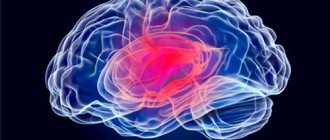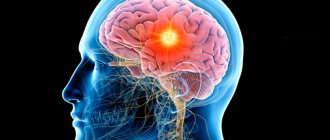Anxious depression is a mental disorder, which in the International Classification of Diseases, Tenth Revision (ICD-10) is classified under heading F41.2 and is called “Mixed anxiety and depressive disorder.”
The clinical picture of this disease equally includes both symptoms of anxiety and symptoms of depression. The causes of this disease are varied and not fully understood. Anxious depression can be caused by hereditary factors, frequent or prolonged stress, traumatic situations, and a violation of the mental mechanisms of adaptation to changes that take place in a person’s life. In all cases, with anxious depression, the exchange of neurotransmitters that regulate the activity of the central nervous system (serotonin, dopamine, gamma-aminobutyric acid, etc.) in the brain is disrupted. This must be remembered when planning treatment, since the process of restoring normal neurotransmitter metabolism is lengthy and requires drug support both at the initial stage of treatment and during the recovery period.
Learn more about your problem by phone
If you are interested in more detailed information on the problem, leave your contact phone number, and the specialist on duty will call you back shortly and answer any questions.
I have read the Personal Data Privacy Policy and agree to the processing of personal data
Fear of “serious illness” is common:
- mental
- oncological
- cardiological
- or some other, unclear but frightening
Fear is accompanied by an obsessive search for signs of this disease.
Long-term anxiety can lead to panic attacks. Often, panic attacks and anxiety coexist with a fear of open or, conversely, too cramped space. There may be a fear of being in an awkward position in crowded places, for example: fainting, committing a senseless act.
Formulations of diagnoses that you may encounter when visiting a doctor
If you have already consulted a doctor or are just planning to do so, then do not be alarmed if you are suddenly given one of the following diagnoses:
- VSD (vegetative-vascular dystonia), NCD (neurocirculatory dystonia)
- neurosis, neurasthenia
- hypochondria, hysteria
- panic neurosis, panic disorder
- post-traumatic stress disorder
- psychasthenia
- generalized anxiety disorder, anxiety neurosis, anxiety-depressive disorder
- astheno-neurotic syndrome, vegetative paroxysms,
- obsessive-compulsive disorder
Unfortunately, many people are accustomed to the fact that an endless state of anxiety is a normal phenomenon, and sometimes they don’t even remember what it’s like to be healthy and live in a good mood.
An anxious state always signals a more global problem - you are not satisfied with your life, and it’s time to do something.
If you have been experiencing emotional discomfort for a long time or have been diagnosed with one of the above, then this treatment and rehabilitation program is for you.
Diagnostic criteria for depressive disorder
1) a sad, gloomy, depressed mood prevails; 2) the attitude towards oneself is based on the belief in one’s inferiority, worthlessness, and low self-esteem; 3) there is a tendency towards self-criticism, self-accusation, and downplaying one’s merits; 4) pessimism and a tendency to experience feelings of guilt or regret are typical; 5) there is a predisposition to sad thoughts and search for reasons for concern; 6) there is a negative, critical or judgmental attitude towards other people. At the same time, patients are friendly, shy, ready to help, and tend to take on the main work. There is a high risk of suicide. Such a complex phenomenon as depressive disorder has several causes.
To confidently diagnose a depressive disorder, the listed symptoms or part of them must be observed for at least two weeks, but if the disorder is severe and the symptoms are severe, a shorter period is sufficient for the diagnosis. Depression varies in severity: mild, moderate and severe. If you think you now know enough to diagnose yourself without the help of a doctor, take your time. Depressive disorder can be masked by irritability, hysterical behavior, aggression, alcohol and drug use (by the way, taking psychoactive substances worsens the prognosis of treatment). Sometimes depression does not manifest itself as obvious mood disorders, but as symptoms reminiscent of diseases of the internal organs or nervous system, and then we talk about “somatized” depression. When, based on these symptoms, we have fears, or even confidence in the presence of some kind of disease, we can talk about hypochondriacal depression. The complexity and diversity of clinical manifestations of depressive disorder have led to the emergence of a number of medical terms: “atypical depression”, “autonomic depression”, “latent depression”. There is even such a term as “depression without depression.” Depression varies from person to person in the number of depressive episodes. Some people experience it only once in their lives, while others experience it more than once. Depression is diagnosed primarily clinically. The doctor simply talks with the patient, analyzes his complaints, asks additional questions and, based on the signs of depressive disorder formulated in the corresponding section of the International Classification of Diseases, makes a professional judgment. A logical question is: what prevents a person who does not have a special education from independently accessing the relevant information, for example, on Wikipedia, and deciding for himself what is happening to him, his relatives or acquaintances? Unfortunately, it doesn't work that way. In fact, depression is a rather complex diagnosis that can be confidently made by excluding a large number of mental illnesses, one of the manifestations of which may be depressive syndrome. These are, for example, some conditions from the group of schizophrenic disorders, consequences of chronic or acute mental trauma, manifestations of individual individual mental anomalies, diseases of internal organs and the nervous system. There are variants of depression, and we have already talked about them above, in which a person is not fully aware of the mood disorders he has. The context in which depression develops is also very important. Mood disorders in adolescents and young adults differ significantly in their manifestations from the same problems in older people. A separate issue is depressive disorders caused by certain physiological characteristics of the female body. It seems to us that we have presented a sufficient number of arguments indicating that the diagnosis of “depression” can only be made by a qualified psychiatrist who, based on his knowledge and clinical experience, can assess the patient’s condition in all its complexity and totality. Another and probably the most serious argument in favor of the inadmissibility of self-diagnosis and self-medication is that severe depression can pose an immediate threat to life. In such a state, a person can make a tragically wrong decision and try to take his own life. The mind refuses to realize that pain and suffering most likely have no real basis in life, but are just manifestations of a disease that will definitely pass, either on their own or as a result of treatment. Thoughts and intentions associated with suicide are not the thoughts of the person himself, but the false thoughts of his illness, which will then be remembered only as a stupid and terrible dream. Depressive disorder has a biological nature established by scientists. This is a deficiency of monoamines (serotonin, norepinephrine and dopamine) - substances that are very important for the functioning of the brain.
Clinical picture (how the disease manifests itself)
Main symptoms include:
- sudden onset of palpitations,
- asthma attack,
- nausea,
- chest pain,
- feeling of unreality (depersonalization and derealization).
- symptom of “cotton legs” - severe weakness in the legs,
- tinnitus, dizziness, darkening of the eyes,
- sensation of hot flashes inside the body.
All this happens against the backdrop of fear of dying, losing control or going crazy. After a panic attack, the patient feels weak and very tired, which is described as a “feeling of soreness.” Between attacks, anxiety persists, the fear that the attack will happen again. After repeated attacks, frightening thoughts appear about the “infinity” of the disease: “it will never end.” Sometimes panic attacks develop against the background of depression.
Panic depression: symptoms and main forms
The clinical picture is characterized by variability of symptoms. At certain moments (under the influence of some external factors), manifestations of depression predominate, in other situations - severe anxiety, up to panic attacks. Typical symptoms of panic depressive disorder are:
- concerns, fears that usually relate to the state of health (a person notices the slightest changes, deterioration in health, is afraid of incurable diseases);
- causeless anxiety;
- irritability and impatience, bad mood;
- inability to relax and, accordingly, a constant feeling of fatigue;
- deterioration in performance, exercise intolerance;
- decreased cognitive abilities;
- sleep disorders.
A person is constantly tense, on the verge of a nervous breakdown, and sometimes he is overcome by a feeling of the unreality of what is happening.
The clinical picture of panic-depressive disorder is complemented by psychosomatic symptoms:
- feeling of tightness, heaviness, chest pain;
- dyspnea;
- sudden changes in blood pressure;
- tremor;
- dry mouth, thirst;
- sweating;
- skin redness;
- abdominal pain, flatulence, imperative urge to urinate and defecate;
- dizziness.
Constant internal tension leads to chronic headaches and myalgia. A person often complains of severe back pain (especially in the lumbar region), spontaneous muscle spasms, unsteadiness of gait, and general discomfort. Severe weakness and depression are also characteristic, due to which the patient cannot fully work, engage in family, or everyday activities.
The patient is confident (sometimes completely unreasonably) in his own incompetence, insolvency and inferiority. He is prone to reflection, perceives everything around him exclusively in a gloomy light. He is tormented by guilt, remorse, his own helplessness and dependence on the support of others. The sense of humor is lost, the patient is very serious, constantly fixated on negative events.
When do you need to use a course treatment program?
You are recommended to undergo the “Not Scary at All” treatment and rehabilitation program if you discover the following symptoms.
- Irritability, fear or anxiety, quickly developing into panic.
- Expectation of trouble or misfortune. Nervous tension. Physical stress. Headache.
- Intestinal dysfunction, diarrhea. Nausea and vomiting. Muscle pain.
- Decreased performance. Insomnia. Sexual disorders.
- Tachycardia (rapid heartbeat), shortness of breath (rapid breathing, lack of air).
- Fear of going crazy or losing control of yourself. A feeling of unreality of the surrounding world, a feeling of time slowing down.
- Fear of “disappearing.” Prostration. Decreased vitality and motivation for life, the perception of the environment is “flat”, “in gray colors”.
- With severe panic disorder, there is a fear that another panic attack will occur spontaneously, “in public.”
Manifestations of anxiety and depression
The leading clinical symptom is groundless anxiety. The patient constantly worries about himself or his loved ones. Gradually a vicious circle arises. The feeling of anxiety stimulates the production of adrenaline, which in turn increases psycho-emotional stress. If this circle is not broken, the condition will most likely only get worse. In addition to anxiety, all patients note other unpleasant manifestations of the disorder:
- Bad mood;
- sleep disturbance;
- decreased concentration;
- increased sweating;
- tachycardia;
- indigestion;
- chills;
- muscle pain, etc.
Treatment of anxiety and depressive disorders in Neurology
Don’t tolerate illness – seek specialized help!
Anxiety and depressive disorders require immediate medical attention due to the high risk of chronicity of the disease. It is not uncommon for acute attacks of fear to continue to torment for years. Fortunately, panic attacks are well treated with modern methods. Neurology statistics show that when completing the course program, significant improvement occurs in the vast majority of cases.
Every day, specialists at the Neuro-PSI clinic analyze world practice in the field of psychiatry and psychotherapy. The goal is the impartial selection and implementation of those methods of treatment and psychological assistance, the effectiveness of which has been convincingly proven in independent studies.
We are guided only by the principles of evidence-based medicine.
What's the difference?
A psychotherapist treats people who are in difficult situations and have developed a mental disorder. The psychotherapist's patient is not registered with anyone and has no restrictions on work or communication. In Europe and the USA, many people have their own personal or family psychotherapist, as well as a personal or family doctor - a specialist in physical illness. And they visit him not at the moment when depression has reached a clinical state, but for almost every reason. At the preclinical stage, so to speak. This is prevention for the health of the soul.
In our country, relatives almost forcefully bring them to a psychotherapist, or patients come to him after a differential diagnosis from a psychiatrist. They determined that it was not yet psychiatry, and transferred it to a psychotherapist. It’s an excellent position, isn’t it, to procrastinate until the intervention of a psychiatrist is required! It’s like not going to a cardiologist and then having a cardiac resuscitator transfer you to him...
Anxiety or depressive disorders currently affect about 10% of people. That is, every tenth person you know needs the help of a psychotherapist. Or... to you?
There is no need to endure, search on the Internet for “can anxiety depression be cured,” or drink all kinds of sedatives in a row. The Internet does not see or understand you personally, and the knowledge put into its “head” is very different. And sedatives relieve symptoms (if they relieve them at all), but do not treat the cause.
What is the essence of the treatment program for anxiety-phobic disorder?
Any mental disorder greatly affects the quality of life and keeps you in constant tension, so our task is to quickly relieve you of panic attacks and chronic anxiety, teach you self-control skills and return you to a full life.
Clinic specialists (psychologists, psychotherapists, psychiatrists) carry out comprehensive work with the client, taking into account the main factors that create well-being. The main emphasis is on teaching the client the correct reaction to his thoughts, emotions, internal sensations and interpretation of external events.
Anxiety disorders and anxiety attacks
It's normal to feel anxious in the face of a difficult situation, such as a job interview, a difficult exam, or a blind date. But if your concerns and fears seem overwhelming and interfere with your daily life, then you may be suffering from an anxiety disorder. There are many different types of anxiety disorders and many effective treatments and self-help strategies. Once you have determined that you have an anxiety disorder, there are steps you can take to reduce your symptoms and regain control of your life.
What is the meaning of anxiety disorder
Anxiety is the body's natural reaction to danger. This is an automatic alarm that comes on when you feel threatened, under pressure or are faced with a stressful situation.
In moderation, anxiety is not always bad. In fact, anxiety helps you stay alert and focused, stimulates action, and motivates you to solve problems. But when anxiety becomes constant or overwhelming, when it interferes with your relationships and activities, it ceases to be functional. This means you've crossed the line between normal, productive anxiety and anxiety disorder territory.
Do you have symptoms that indicate an anxiety disorder?
If you find yourself with several of the following symptoms that just won't go away, you may be suffering from an anxiety disorder.
- Are you constantly tense, worried, or irritated?
- Do you suffer from fears that you agree are irrational, but you can't get rid of them?
- Do you believe that something bad will happen if certain things are not done a certain way?
- Do you try to avoid everyday situations or activities because they make you feel anxious?
- Do you experience sudden and unexpected panic attacks and heart palpitations?
- Do you feel like danger and disaster await you around every corner?
Signs and symptoms of anxiety disorders
Because anxiety disorders are a group of related conditions rather than a single disorder, they can vary greatly from person to person. One person may suffer from intense anxiety attacks that come without warning, while another may panic at the thought of a crowded party. Some may struggle with a crippling fear of driving or uncontrollable intrusive thoughts. And some may live in constant tension, worrying about nothing and everything at the same time.
Despite their different forms, all anxiety disorders share one core symptom: persistent or severe fear or worry in situations that most people would not feel threatened by.
Emotional symptoms of anxiety
In addition to the primary symptoms of irrational and excessive fear and worry, other common emotional symptoms of anxiety include:
- Feeling of danger or fear.
- Problems concentrating.
- Feeling nervous and tense.
- Expecting the worst.
- Irritability.
- Restlessness, impatience.
- Look out for signs of danger.
- Feeling like your mind is empty.
Physical symptoms of anxiety
Anxiety is more than just a feeling. As a consequence of the body's fight-or-flight response, anxiety includes a wide range of physical symptoms. Due to its many physical symptoms, sufferers often mistakenly consider anxiety to be a medical problem. They may visit many doctors and make numerous trips to the hospital before their anxiety disorder is discovered.
Common physical symptoms of anxiety include:
- Cardiopalmus
- Increased sweating
- Upset stomach or dizziness
- Frequent urination or diarrhea
- Irregular breathing
- Tremor
- Muscle tension
- Headache
- Fatigue
- Insomnia
- Link between anxiety symptoms and depression
- Many people with anxiety disorders also suffer from depression at some point. Anxiety and depression are believed to stem from the same biological vulnerability, which may explain why they so often go hand in hand. Since depression worsens anxiety (and vice versa), it is important to seek treatment for both conditions.
Anxiety attacks and their symptoms
Anxiety attacks, also known as panic attacks, are episodes of intense panic or fear. Anxiety attacks usually occur suddenly and without warning. Sometimes there's an obvious trigger—you're stuck in an elevator, for example, or you're thinking about an important speech. But in other situations, panic attacks come out of nowhere.
Anxiety attacks usually peak within 10 minutes, and they rarely last more than 30 minutes. But in that short period of time, the horror can be so severe that you feel like you're going to die or completely lose control.
The physical symptoms of an anxiety attack themselves are so frightening that many people believe they are having a heart attack. After an anxiety attack has ended, you may worry that it will happen again, especially if it happens in a public place where help is not available or where you cannot simply escape.
Symptoms of an anxiety attack include:
- A burst of overwhelming panic
- Feeling out of control or crazy
- Palpitations or chest pain
- Feeling like you need to get out or leave
- Difficulty breathing or feeling of suffocation
- Hyperventilation
- Hot flashes or chills
- Trembling or shaking
- Nausea or stomach cramps
- Feeling disconnected from reality, unrealistic
It is important to seek help immediately as soon as you start avoiding certain situations or places because you are afraid of experiencing an anxiety attack. The good news is that panic attacks are highly treatable. In fact, many people get rid of panic after 5-8 treatment sessions.
Types of Anxiety Disorders
There are six main types of anxiety disorders, each with their own set of different symptoms: generalized anxiety disorder, obsessive-compulsive disorder, panic disorder (anxiety attacks), phobias, post-traumatic stress disorder and social anxiety disorder.
Generalized anxiety disorder
If persistent worries and fears distract you from day-to-day activities, or you have a persistent feeling that something bad is about to happen, you may be suffering from generalized anxiety disorder (GAD). People with GAD are chronic panickers who feel anxious almost all the time, although they may not even know why. The anxiety associated with GAD often manifests itself as physical symptoms: insomnia, stomach upset, restlessness, and fatigue.
Panic disorder (anxiety attacks)
Panic disorders are characterized by repeated, unexpected panic attacks, as well as the fear of experiencing another episode. Panic disorders can also be accompanied by agoraphobia, a fear of going to places where it would be difficult to escape or get help in the event of a panic attack. If you have agoraphobia, you most likely try to avoid public places, such as shopping malls, or enclosed spaces, such as airplanes.
Obsessive-compulsive disorder
Obsessive-compulsive disorder (OCD) is characterized by unwanted thoughts or behaviors that cannot be stopped or controlled. If you have OCD, you're likely worried about intrusive thoughts, such as recurring worries that you forgot to turn off the oven or that you might hurt someone. You may also suffer from uncontrollable urges, such as washing your hands over and over again.
Phobia
A phobia is an unrealistic or exaggerated fear of a specific object, activity, or situation that in reality poses no danger. Common phobias include fear of animals (such as snakes and spiders), fear of flying, and fear of heights. In the case of a severe phobia, a person may even go to extreme measures to avoid what they fear. Unfortunately, avoidance only makes the phobia worse.
Social anxiety disorder
If you have an overwhelming fear that others will see you less well or humiliated when you are in public, you may be suffering from social anxiety disorder, also known as social phobia. Social anxiety disorder can manifest as extreme shyness. In severe cases, people generally avoid any social situations. Stage fright is the most common type of social anxiety disorder.
Post-traumatic stress disorder
Post-traumatic stress disorder (PTSD) is an extreme anxiety disorder that can occur in the aftermath of a traumatic or life-threatening event. PTSD can be confused with panic attacks that rarely, if ever, go away. Symptoms of PTSD include flashbacks, nightmares about what happened, hypervigilance, constant states of fear, withdrawal from others, and avoidance of situations that in some way resemble about the event.
How to Help Yourself with Worries, Anxiety Attacks, and Anxiety Disorders
Not everyone who worries a lot has an anxiety disorder. You may feel anxious due to an overly busy schedule, lack of exercise or sleep, pressure at work or home, or even too much coffee.
The bottom line is that if your lifestyle is unhealthy and full of stress, you most likely just have anxiety, and if not, you actually have an anxiety disorder. So if you feel like you're worrying too much, take some time to evaluate how well you're taking care of yourself.
- Do you leave time every day for relaxation and entertainment?
- Do you get emotional support when you need it?
- Do you take care of your body?
- Are you overloaded with responsibilities?
- Do you have the ability to ask for help when you need it?
If your stress levels are excessive, think about how you can bring balance to your life. These may be responsibilities that you can reduce or delegate to others. If you feel isolated or lacking support, find someone you can confide in. Even just talking about your worries can help make them less scary.
How to take care of yourself
- Connect with other people . Loneliness and isolation only create grounds for anxiety. You can reduce vulnerability by starting to reach out to people. Challenge yourself to meet with friends more often, join a support or self-help group, or start sharing your worries and problems with a loved one.
- Practice relaxation techniques . By regularly practicing relaxation techniques such as mindful meditation, progressive muscle relaxation and deep breathing, you can reduce symptoms of anxiety and increase feelings of relaxation and emotional well-being.
- Exercise regularly . Exercise is a natural reliever of stress and anxiety (psychological-benefits-from-exercises). For maximum benefits, perform aerobic exercise for at least 30 minutes a day.
- Get enough sleep . Lack of sleep can make anxious thoughts and feelings worse, so try to get seven to nine hours of sleep at night. If you're struggling with sleep problems, practicing habits to help you cope can help.
- Consume caffeine and alcohol in reasonable quantities . If you struggle with anxiety, you might consider cutting back on caffeine or consider cutting it out completely. The same goes for alcohol, which can make anxiety worse.
- Train your brain to stay calm . Worrying is a psychological habit that... Strategies such as setting aside a special period for worry, combating negative thinking, and developing skills to accept uncertainty will reduce fears and worries.
When to Seek Professional Treatment for Anxiety Disorders
Although self-help strategies for overcoming anxiety can be very effective, if your concerns, fears, or anxiety attacks have become so severe that they are disrupting your daily life, it is important to seek professional help.
The specific treatment method depends on the type of anxiety disorder and its severity. But in general, most professionals treat anxiety with behavioral therapy, medication, or a combination of both.
Psychotherapy for anxiety disorders
Anxiety disorders respond very well to treatment, often in a relatively short period of time. The following types of therapy can help with problems such as panic attacks, generalized anxiety, and phobias.
- Cognitive behavioral therapy focuses on thoughts (or cognitions) and behavior. When treating anxiety, cognitive behavioral therapy identifies and challenges the negative thought patterns and irrational beliefs that fuel anxiety.
- Exposure therapy for anxiety disorder focuses on confronting your fears in a safe, controlled environment. Through repeated exposure to either a feared object or situation in your imagination or in reality, you gain a greater sense of control. Because you face your fear without external threats, your anxiety gradually decreases.
Cognitive behavioral therapy and exposure therapy are types of behavioral therapy, meaning they focus on behavior rather than on underlying psychological conflicts or problems from the past.
If therapy doesn't work...
If you have been in psychotherapy for a while and have not made progress, consider whether there is a more complex emotional problem underlying the anxiety. Anxiety is a common symptom of trauma that requires a different approach to treatment.
Drug treatment for anxiety disorders
If you have anxiety that is severe enough to interfere with your functioning, medication treatment may help relieve symptoms. However, medications can cause addiction and unwanted side effects, so be sure to consider all alternative options. Many people use anti-anxiety medications, while psychotherapy, exercise, or self-help groups work just as well or better without causing side effects. It is important to weigh the benefits and risks of using medications to make a final decision.
Rule out medical causes of concern
If you are experiencing many physical symptoms of anxiety, get a physical exam. The doctor will check to see if your anxiety is caused by a medical problem: a thyroid problem, hypoglycemia, or asthma. Also, some medications and supplements may cause anxiety, so your doctor should be aware of all medications you take.
Authors: Melinda Smits, Lawrence Robinson, Gene Segal, Ph.D. n.
Translation: Maria KorzhOriginal source: https://mentalhelpguide.ru/
What treatment methods are used?
Primary: cognitive behavioral psychotherapy. (the gold standard for the treatment of panic and anxiety disorders throughout the civilized world)
Besides:
- stress exposure,
- breathing techniques training,
- training in progressive muscle relaxation techniques,
- therapy using a biofeedback system,
- self-control training,
- modernization of lifestyle,
- resolving family conflicts,
- assistance in self-realization and establishing relationships,
- specific drug therapy (for severe disease).
Why are these particular methods used?
If you have tried other methods before, then you know that hospitalization, massage, exercise therapy and acupuncture bring only temporary relief, since they do not affect the mental sphere, on which the condition of the entire body depends.
Causes and symptoms
The reasons for the development of this disease can be regular stress, psychological trauma, various unpleasant situations and events, problems in relationships with loved ones, the opposite sex, psychological violence in childhood or adulthood. However, such a deviation in the psycho-emotional state is not only a consequence of injuries, it is also various changes at the physical level. In particular, patients have a lack of vitamin D, iron and some other microelements and biologically active substances.
In addition, the development of the disease is largely influenced by hormonal disorders and diseases of the endocrine system. Quite rarely, the disorder occurs as a side effect of taking medications, but this is usually prescribed in the instructions. Vitamin D deficiency is associated with a lack of sun; in the fall and spring, many people experience exacerbation of mental disorders.
How does the treatment program work?
Each treatment program at the NEUROPSI consists of four stages:
- diagnostics
- working with symptoms of the disease
- working with the causes of the disease
- consolidation of achieved results
Work efficiency is increased by accurately planning the time required to achieve therapy results. This means that each program is adapted to the problem that the client has addressed.
The program method of treatment is predictable, time-limited, productive, and most importantly, understandable to the client.
Of course, treatment takes place in a comfortable manner without interruption from work, study or family. Specialists of various profiles will work with you (team method). This is necessary to minimize the risk of diagnostic errors that could lead to the adoption of a suboptimal treatment plan.
Improvements in well-being and mood (healing) occur in stages: following a decrease in emotional problems, physical symptoms decrease. Working with the causes of anxiety and phobias allows you to avoid relapses in the future.
Causes of anxiety and depression
Many factors can lead to the development of this syndrome:
- mental trauma (frequent stress, constant exposure to psycho-emotional stress, etc.);
- organic changes in the brain as a result of traumatic brain injury, circulatory problems, poisoning, addiction, inflammation;
- epilepsy;
- lack of essential amino acids and serotonin;
- hereditary predisposition;
- taking certain groups of medications (barbiturates, anticonvulsants, estrogens, etc.).
What are the results and prognosis?
Upon successful completion of the program, you will get rid of unmotivated fears, panic attacks and multiple vegetative symptoms (sudden surges in blood pressure, rapid heartbeat, dizziness, nausea)
According to statistics, the effectiveness of the methods used is close to 100% if all recommendations of specialists are followed.
Skills you acquire during the program:
- self-control and self-regulation
- constructive analysis of the body's condition
- understanding your own mental and emotional sphere
- ability to act consciously in stressful situations
The emotional and physical state improves significantly, and confidence in oneself and the future is gained. Emotional stress is relieved, sleep and appetite are restored. Performance increases many times over.









